For grayling and good fishing during the spring melt, check out Yellowstone Park lakes.
Lakes in Yellowstone Park are a secondary choice for most anglers. For one thing, most fly anglers don’t like lakes as much as streams. For another, there just aren’t that many good lakes in Yellowstone Park. For someone driving through the park and seeing lake after lake, that might come as a surprise. The ugly fact is that the vast majority of lakes in Yellowstone Park are actually fishless, including almost all (besides the large Yellowstone and Lewis Lakes) that sit right next to the roads.
There are several reasons for this. First, Yellowstone Park does not stock fish, so waterbodies must be able to support trout year-round and provide suitable structure for natural reproduction. All trout besides lake and brook trout (which are actually char) require flowing water to spawn. So no year-round inlet or outlet stream means no trout. Freezeout is another concern. Beautiful Swan Lake is only three or four feet deep, so it often freezes all the way to the bottom in winter. Some lakes are eutrophic, so full of algae and vegetation that the decay of these plants consumes all the oxygen in the fall. Finally, hot spring discharge can concentrate in lakes, making them too toxic to support trout even if they aren’t too warm.
This adds up to mean there aren’t many lakes worth visiting. Those that are worth visiting usually require hikes, and some (Yellowstone and Trout) are not easy to fish. On the other hand, lakes often fish great early in the season when there aren’t many flowing water options in the region, and they can provide very different experiences than rivers, either unusual species (grayling) or common species that get larger than average (the park’s largest brook trout).
The lakes discussed below are all within 3 hours of Livingston, including both driving and hiking time. There are plenty of other lakes in the park, particularly in the backcountry in the southern part of the park, but none of these are within realistic day-trip range of Livingston, or even of Gardiner at the park’s north entrance.
- We love running Walk & Wade Guided Trips on lakes in Yellowstone Park, especially trips into the grayling lakes in the middle of the park in the month of June.
The Lakes
The lakes pinned on the following map are discussed in increasing total travel time from Livingston, from Joffe Lake less than 20 minutes from Gardiner even with typical park traffic and a rough road at the end to McBride Lake, a 4–6 mile hike following almost 2hr of driving, and therefore quite a stretch from Livingston.
Joffe Lake
Joffe (sometimes spelled Joffee) is a small L-shaped pond just south of Mammoth Hot Springs. It’s actually a reservoir formed by the overflow from the Mammoth Hot Springs water supply reservoir (which is at best a gray area as far as being a legal fishery). Long populated exclusively by brook trout, recent efforts to establish Yellowstone cutthroat in the lake have not done very well. The average brook trout here are hand-size, but some years there are some bigger ones. I’ve seen a few 14-inchers. This lake is notable since it’s always fishable from the beginning of the park season, which isn’t true for any other body of water near Gardiner.
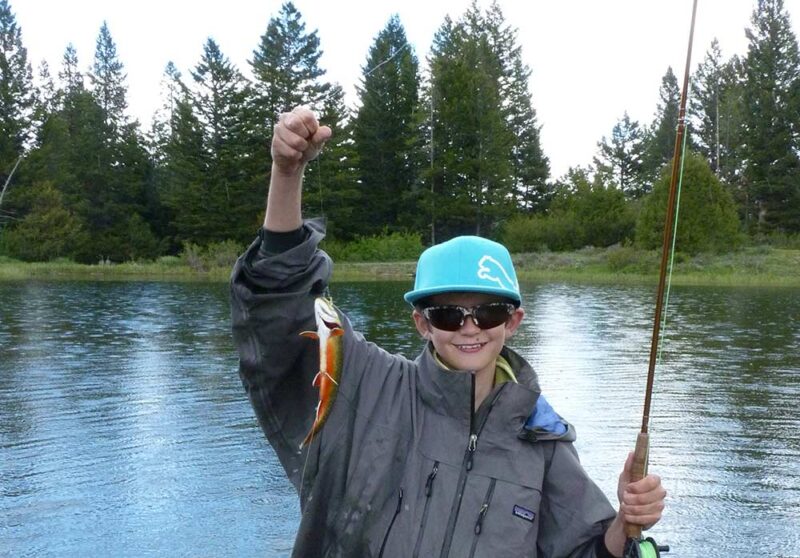
Joffe Lake is a good early-season bet with young anglers.
Joffe is a popular lake for local families, since it’s a drive-up lake no more than 20 minutes from Gardiner. It fishes well on June evenings. Stripping leeches and soft hackles or chironomid pupae on slow sink-tips or twitching them under indicators are the best tactics. Later in the summer, occasional hatches bring up rising fish, but late summer and fall fishing are slower here.
Access Joffe by taking the stub road that departs the main road at the first switchback south of Mammoth. Bear left at every fork. Drive through the Upper Mammoth housing area, past some warehouses, and past snow machine parking. The road will turn to gravel. Follow it all the way to the lake. Any passenger car can make the drive, but RVs and so on can’t since there’s nowhere to turn around. Watch for bears and moose at the lake, despite how close to Mammoth it is.
Swan Lake Flat Sloughs
These spring holes and sloughs fill the east side of the Mammoth–Norris Road just south of the Golden Gate (Rustic Falls) and north of Swan Lake, with the last “pothole” adjacent to the Bunsen Peak Trailhead. They serve as the outlet of Swan Lake, and feed into Glen Creek. Swan Lake itself is fishless. The sloughs have brook trout that move in from Glen Creek, however. These fish aren’t numerous and seldom crack 12 inches, but they’re there and they eat best for the first three weeks of the season. This makes them an important early-season fishery. I’ve even guided here a few times.
Almost all prey items in the sloughs are small and the brookies here tend to be spooky, so small flies and long casts are the order of the day. I like fishing a pair of chironomid pupae or similar nymphs under a tiny strike indicator, then twitching the combo along the weed beds. If any trout are rising, swap the bobber and one of the chironomids for a midsize Parachute Adams or similar attractor dry.
These sloughs are basically in a giant swamp, so it’s wise to stick to dry ground. I’ve had a hard time extricating myself from the much before. I’ve also been chased out of the area by a cow elk who almost certainly had a calf hiding in the swampy grass. Also be sure to lather up with mosquito repellent. The fishing is more fun than it sounds, I promise.
Blacktail Ponds
The Blacktail Ponds (really just one pond with several “necks”) are a swampy body of water located in a peat bog just west of Blacktail Deer Creek. Spawning habitat and therefore trout numbers are poor, but the lake is spring-fed and hyper-fertile, so the brook trout that live here get big. They average 14–16 inches but can reach 20 or more. They are not pushovers, however. One or two fish is a fine morning.
The best tactic here is to fish a slow sink-tip line with a leech and freshwater shrimp fly pairing. Retrieve them as slow as you can stand it, two inches at a time. This lake is so rich that there’s no reason for the trout to chase food. They just swim around opening their mouths and swallowing whatever falls in. Hits are thus very subtle. You can fish using this technique either from shore or from a float tube. The tube is safer.

Why safer? Because of the peat bog. This lake is known locally as “Shakey Lake” because the banks are really just mats of vegetation suspended in the mud. Jump up and down and you’ll bounce like you’re on a trampoline. It’s very easy to fall through soft areas in the vegetation and get stuck in the muck. You must fish this water with a partner. I once had to rescue my dad after he got stuck crotch-deep in the muck.
The strange surroundings lead to strange wildlife. Rare ground-nesting shorebirds nest here, which keeps the lake closed until early July. Check current regulations, as the date is prone to change (though it’s always the first few days of the month). The fishing is best for the first week of the season, then again after September 20. Mornings and perhaps late evening are best. Late summer fishing is nonexistent due to warm water. The fish just tuck down into the spring holes to wait it out.
Access Blacktail Ponds via the Mammoth–Tower Road. The ponds are right off the road.
Trout Lake
Trout Lake is located just west of the rapids between Round Prairie and the Junction Meadow on Soda Butte Creek. The lake is less than a mile up a steep trail from the Northeast Entrance Road.
This bowl-shaped pond was once used as a hatchery, and formerly held both native cutthroat and extremely large rainbow trout. Strangely, these species never hybridized. This might be explained by the tiny inlet stream, which is steep and has very limited spawning habitat. Basically, the rainbows went in and did their business and got out again in April and early May, the cutthroats in June and early July, and there was no reason for these fish to stick around to mix with each other. The inlet is strictly spawning water. It is permanently closed to fishing.
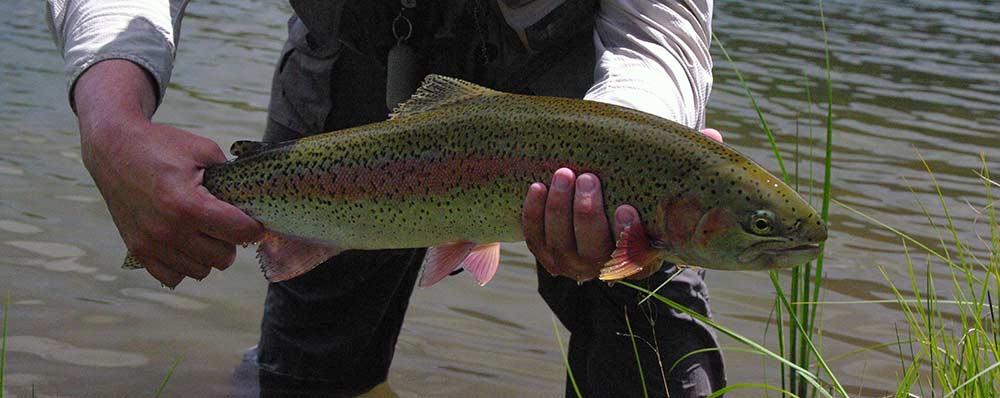
This one is just bragging. I caught this rainbow on my 29th birthday. Nowadays Trout Lake holds few rainbows, if any.
The poor spawning habitat plus a high population of otters leads to a low trout population, but the trout are big. Before the rainbows were removed in recent years, some of them occasionally reached ten pounds. My best was over 24 inches. The cutthroats aren’t quite so big, but they still average 15–20 inches and get larger. They are never easy, though. I’ve never had a client catch more than three in a morning.
Three tactics make sense here, all of which work best from around 9:00AM to noon or until the wind comes up, whichever comes first. The best is to creep along the banks with a single nymph in your hand, looking for trout cruising the shallows. Cast only when you see a feeding fish, and make the cast count. The second tactic is more boring but almost as effective. Cast a pair of chironomid pupae or a pupa and a scud under an indicator out beyond the color change on the bottom. Let it sit, with no retrieve save an occasional twitch. It’s a drag until you hook one. If any trout are rising, you can sub a Trude or Parachute Adams for the bobber and one of the flies. The final tactic is to troll similar flies or perhaps a leech on a sinking line, getting your “leg day” in via float tube. If you do this, give bank anglers plenty of room. I once put a cast over a float tuber’s fins when he trolled fifteen feet in front of me.
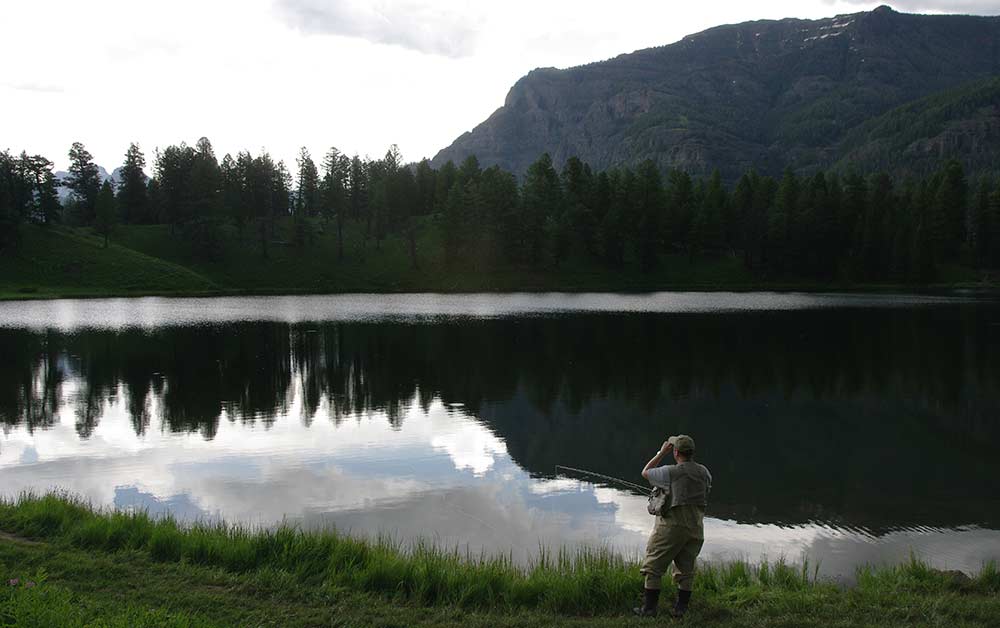
In addition to the above, there’ also occasional evening caddis hatches in July, but these are rare. The best fishing on Trout Lake is from the season opener until mid-July. Just leave the inlet alone, no matter how many fish are jammed into it spawning. They need the space and time to do the job.
The biggest problem on Trout Lake is crowds. Not of anglers, usually, but of regular tourists. This is a short, popular hike to a pretty lake with photogenic otters often visible, so there’s often a parade of tourists circling the lake. They spook the shore-cruising trout into deep water and also tend to wander into your backcast without realizing they’re inviting injury.
Access Trout Lake via the Trout Lake Trail along the Northeast Entrance Road. Note that Shrimp and Buck Lakes further up the hill are fishless.
The Grayling Lakes: Cascade, Grebe, and Wolf
I sort of buried the lede here. The three lakes in the center of Yellowstone Park (Cascade, Grebe, and Wolf, from east to west) that hold Arctic grayling are far and away the most interesting lakes in Yellowstone Park for most visitors. Not only do these lakes produce lots of “bucket list” grayling without the expense of an Alaska trip, they’re among the park’s most productive waters overall early in the season and require easy hikes to reach.
Cascade Lake feeds into the Yellowstone River via Cascade Creek. Grebe and Wolf Lakes are the headwaters of the Gibbon River. All three lakes sit roughly side by side in the same approximate depression near Canyon Village. In fact the “Chain of Lakes” is a popular day-hike even for non-anglers. It’s an easy all-day hike to view all three lakes. Most anglers visit only one lake.
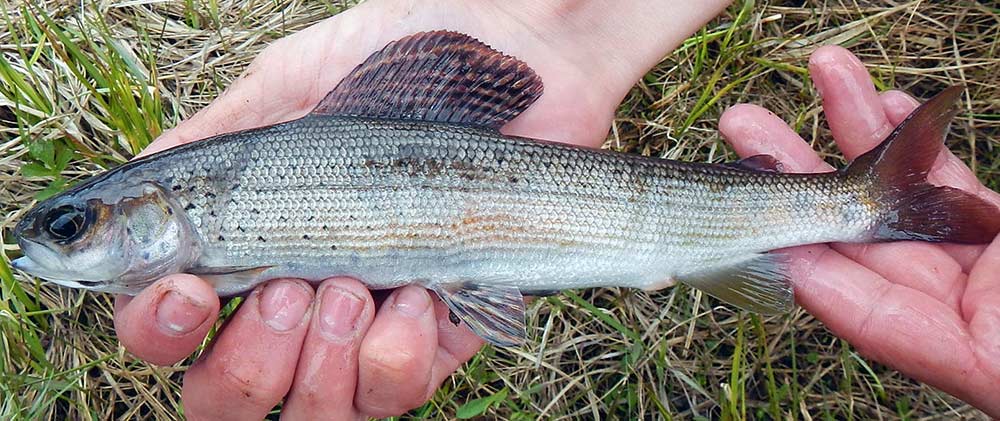
Cascade is the easiest to reach, at about 2.5 miles via either the Cascade Lake or Cascade Creek Trail, one trail heading just east of Canyon Village and the other just north (the trails merge halfway to the lake). This is the most consistent and easiest-to-fish of the lakes. The trail follows the north shore, which is also where the best fishing I’ve found is. In addition to grayling, Cascade Lake holds Yellowstone cutthroat. Both species average 7–10 inches with a few around 12 inches, but there are large numbers of both. I guide beginners here in mid-June often, and ten fish per rookie is more common than two. The only problem with Cascade Lake is the wetness of the hike in. Particularly in June following wet winters, you should expect to walk in ankle-deep water and mud at least half the distance to the lake. I often wear waders for the walk at this time. Please stick to the muddy trail rather than cutting a new trail through the seemingly-dry tall grass. I expect the Park Service to eventually close access to Cascade Lake because of all the erosion caused by such trail-cutting.
Grebe Lake is probably the most famous of the lakes. It’s a bit over 3mi to the lake via the Grebe Lake Trail, but the best water for anglers without a float tube is near the outlet. This is about another mile via a trail around the north shore of the lake. The entire hike is basically flat and is drier than the hike to Cascade. If the outlet is occupied, fish where trickles come down into the lake from the north. Formerly home to grayling and rainbow trout, the lake was poisoned several years ago and the grayling strain was replaced with one native to the Missouri River System (the Gibbon is one of the headwaters of the Missouri) elsewhere in Montana and the rainbows replaced with westslope cutthroats. This fisheries project seems to have succeeded wildly. The average fish prior to the project ran 7–12 inches, with a few rainbows to 16 inches, but the fish now seem to average 12–14 inches and it seems to be a matter of time before somebody gets a 20-inch cutt (probably not a grayling, though). Because it has fewer but larger fish than Cascade, and usually requires longer casts, Grebe is not as rookie-friendly as Cascade.
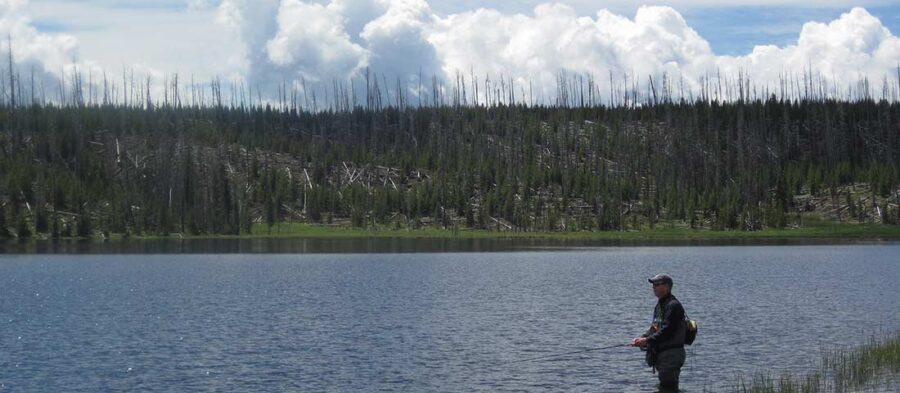
Cascade Lake. Grebe looks fairly similar, though often has steeper banks. Wolf Lake is more wooded.
Wolf Lake requires the longest hike of the three lakes and is the most difficult to fish due to encroaching timber behind and aquatic plants in front. This is the only lake of the three where it’s more common to fish in solitude than with several to a couple dozen other anglers. The best fishing is on the lake’s south shore. The north shore of the lake is shallow and somewhat stagnant, since the Gibbon River enters from the southeast and exits from the southwest corner of the lake. The same fisheries project that replaced the trout in Grebe (and the Gibbon) swapped the fish here. The same success story seems to be taking place. I had reports in 2022 of lots of 13-inch westslopes being caught. Reach Wolf Lake via the Wolf Lake Trail, which generally follows the Gibbon River from Virginia Meadows. It’s about 3.5mi to the lake with some short climbs and descents.
Fishing in all three lakes is best from when the lakes become accessible sometime in the first ten days of June (snow and mud making the trip treacherous before this) through July, but these lakes are at high-enough elevation that they can fish well all summer and through September, particularly in the mornings. Highlights of the season include the damselfly hatches in late June and early July, which are heavier on these lakes than on any others in the park.
Despite their differing fish populations compared to other lakes in the park, the grayling lakes require similar flies and tactics. See the “Angling” section below for more details.
All three lakes have backcountry campsites along their shores, though the hikes are short enough there’s no reason to stay overnight unless you want to.
Yellowstone Lake
Yellowstone Lake is the largest alpine lake in North America. As such it’s an imposing body of water for bank-bound and boat anglers alike. This is not a place for small watercraft. Park lodging concessionaire Xanterra runs power boat fishing trips here, and they use 22-foot Grady White ocean-style boats. The lake can sometimes be too rough even for these craft, much less a smaller boat. On the other hand, float-tubers can easily launch in sheltered coves even when the main lake is rough, and wading anglers willing to brave the spray and waves can access the lake via many beaches, coves, and picnic areas on the lakeshore. The lake is followed by the East Entrance Road on the north shore and by the Lake–Grant Road on the west shore. These roads provide the only sensible access from Gardiner. Hiking or taking a boat to the east or south shore is a much more involved trip that should begin in Jackson, Cody, or one of the lodging developments near the lake itself.
Yellowstone Lake is home to native cutthroat trout and illegally-introduced lake trout. The latter decimated the former from the mid-1990s through roughly 2010, and are still a menace despite concentrated suppression efforts. The Park Service spends much of its fisheries budget to pay multiple commercial gill-netting crews to net the lake trout, and more esoteric efforts such as poisoning lake trout spawning areas are underway.
Prior to the lake trout crashing the cutthroat population, Yellowstone Lake was known as a place anglers could reliably catch lots of 13–20″ cutthroats, both from shore and from boats or float tubes. When I first began fishing Yellowstone Park in 1993, my dad and I caught dozens of cutts during Callibaetis hatches. By 1999, we were lucky to catch a handful. The situation has improved somewhat, but Yellowstone Lake is not a numbers game. Instead it’s a place where you hope to catch a handful of near-trophy cutthroats. The average fish is now in the 20″ class, and I’ve caught them to 25 inches (on spoons, while targeting lake trout, unfortunately).
The cutthroat fishing is best in late June and July and slowly declines until Labor Day, after which it ticks back up again. Unless you see rising trout, the best tactic is to fish a leech or Woolly Bugger with a nondescript nymph like an unweighted Hare’s Ear or some sort of soft hackle on a dropper. Blind cast (or troll, if you have a watercraft) along drop-offs, rock piles, areas where the interactions between the wind and the shoreline create “seams” etc.
Lake trout are also a worthwhile target species. Target them with gray and white baitfish patterns like large Double Bunnies that suggest baby cutthroats. They will also take other streamers, both the buggers and leeches the cutts eat and classic lake trout color combos like red and white and yellow and red. Note that there aren’t many large lake trout left in Yellowstone Lake. The Park Service and commercial netters have done a good job knocking the high end off the laker population, the sort of fish that could eat a 12″ cutthroat daily. In talking to commercial power boat guides, I understand that 5lb lake trout are now uncommon, and one gear-fishing guide was ecstatic to have landed one that cracked ten. All lake trout caught must be killed and either eaten or disposed of by popping their air bladders and cutting their gills, then depositing them in deep water (chucking them out to sea, basically).
Grizzly Lake
Grizzly Lake drains into the Gardner River System via Straight Creek. This long, narrow brook trout lake is a popular day-hike and tends to produce good numbers of brook trout slightly larger than those seen in the nearby streams. The hike’s a bit over 2mi one-way, though it does require a climb over a ridge going both ways. It fishes best in late June and early July, though the mosquitoes can be pretty awful at this time.
Access Grizzly Lake via the Grizzly Lake Trailhead about 2/3 of the way to Norris from Mammoth on the Mammoth–Norris Road.
Fawn Lake
Fawn Lake requires a five-mile one way hike including crossings of the upper Gardner River and Fawn Creek. The last half-mile is off official trails, though there’s a well-beaten angler’s track that leads to this small, shallow, weedy pond. Why a well-beaten track to a puddle so far into the backcountry? Because it holds large brook trout and is open all season.
Fawn Lake is a hyper-fertile spring-fed lake full of aquatic vegetation and the bugs and creepy-crawlies that feed on them. Like those in Blacktail Ponds, the brook trout here can be as lazy as they want to be. These are usually a little easier to catch, though. A big part of this is the fact the lake is open from the beginning of the season. It usually loses its ice right around the opener. I fished it on the second day of the season once and the lake was still half-frozen. The fishing is best for the first three weeks of June and perhaps again from September 20 through mid-October, though the fall fishing is nowhere near as consistent.
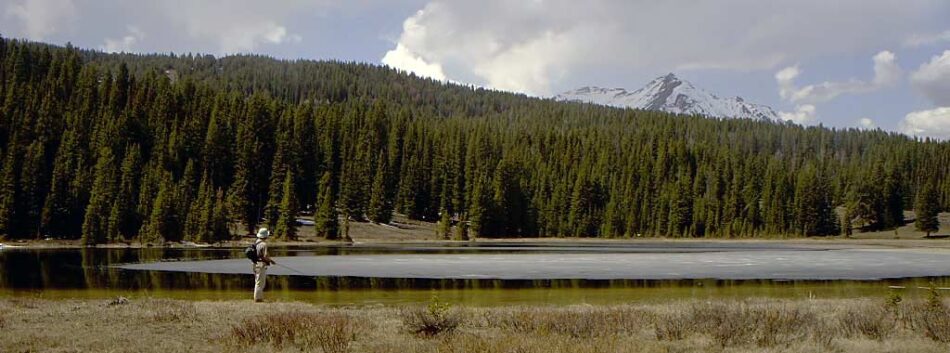
The brook trout generally run 14–16 inches nowadays. It seems like there are more now than when I started fishing here in 2001, but they’re smaller. I never got one over 18 inches, but I know several people who got fish to 22 inches in the 1990s. That’s a trophy brook trout anywhere except Labrador.
Access Fawn Lake via the Fawn Pass Trail. Follow it until it crosses Fawn Creek, then look for the angler’s track that follows the unnamed and fishless outlet stream up to the lake. There’s a backcountry campsite north of the lake.
McBride Lake
McBride Lake is a long, narrow lake with steep banks set into the first hills west of Slough Creek, roughly between the First and Second Meadows. A couple tiny inlets and a marshy outlet to the lower Second Meadow provide spawning habitat, and the latter probably also allows interchange of fish with Slough Creek when the water is high. The fish here are cutthroats averaging 16 inches. The downside is the hike. The short way is over four miles and involves some off-trail navigation. The long way is six miles. Both require fording Slough Creek, which is seldom possible before mid-July.
Despite the difficulty of access, McBride is a popular fishery for lake fanatics. It fishes well all summer (though it’d probably be gangbusters in June if you were crazy and swam across Slough Creek). Leeches, Callibaetis, and somewhat unusual (for Yellowstone) flies like Clouser Minnows (tied with brass eyes to be legal) work well, though back-casting can be problem in spots due to the steep, rocky banks that line much of the lakeshore. On the other hand, the steep drops mean the fish stay close to shore later in the summer than in most lakes.
Access McBride via the Slough Creek Trail. Take the unsigned stub trail that veers off towards the upstream end of the First Meadow. Ford the creek, then follow the angler’s track up to the lake. It sits west of the first hill. Alternately, hike southwest from the bottom end of the Second Meadow up the obvious marshy outlet.
Angling
Lakes in YNP Fishing Tactics
Lakes in Yellowstone tend to fish rather similarly. Absent a hatch, start with a pair of subsurface flies. Early in the season, rig a leech with a chironomid pupa or attractor nymph suggestive of chironomids (my favorite is the BLM), either on a slow sinking line or under an indicator. The larger the lake, the more likely I am to use a sinking line. On hyper-fertile lakes like Trout and Fawn, you might swap a scud for the chironomid. Fish these flies slowly.
Once you start seeing occasional rises, swap the leech for another nymph. I’ll often fish a slightly-weighted Callibaetis or chironomid with an unweighted one behind it, while damselflies can swap in beginning about June 25 most years. Begin fishing shallower rather than right over the weed-tops or bottom. It often makes sense to cast to rises with subsurface flies, before there are enough rising fish to throw dries.
If trout are showing themselves in the shallows but not rising, it makes sense to pull the bobber off and sight-fish with similar flies. Stalk the banks looking for cruisers. This tactic works best on lakes with sparse fish populations, like Trout or Yellowstone.
When trout are rising, they’re generally taking chironomids (big midges) or Callibaetis. A Parachute Adams can imitate both, while a small Trude is a good chironomid emerger. Don’t hesitate to twitch these flies, and always fish a lightly-weighted nymph on the dropper. If the rises are particularly splashy, the trout could be eating something else. Damselflies are most likely. If you see blue damsels in flight and the rises are extremely aggressive, with many fish coming clear out of the water, odds are the trout are eating damsels. If you’re seeing large “moths” flying and often seeing vee-wakes in the lake, the fish could be taking Traveling Sedges, the only common lake caddis and a very large one. The pupae hatch by swimming aggressively just beneath the water surface, then popping through the film and flying away. Look for birds dive-bombing the water. These hatches are most common in the evening, and only Trout and Fawn Lakes see anything resembling reliable hatches.
While some lakes can fish well all day and all season, most lakes fish best from midmorning until midafternoon or whenever the wind kicks up. Most lakes are not places you want to be in the evenings unless you’re staying overnight, but lakes accessible via road can also be good for the hour or so before dark when the wind drops.
Insect Hatches & Other Prey
Hatches are not as important on lakes in Yellowstone Park as they are on streams. Really the only hatches that often get the trout excited are Callibaetis, chironomids (midges #14–16), and damselflies. I’ve seen the others a time or two, but no more. Gray Drakes are only found in fishable numbers in Yellowstone Lake.
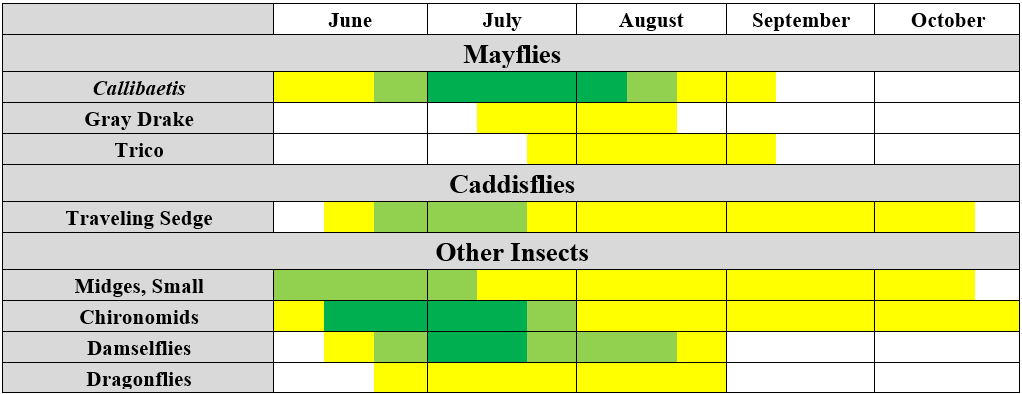
Stillwater fly patterns tend to be very different from those used on streams. I actually carry an entirely separate specialty box when guiding/fishing on lakes. It’s often better to fish unweighted versions of good river flies, if you use them on lakes. Unweighted Prince nymphs are good imitations of large chironomid pupae and Callibaetis nymphs, for example. I don’t know if I’ve ever caught a fish in a lake on a beadhead Prince, and on streams I never use Princes that aren’t beadheads.

Top 10 Flies for Yellowstone Park Lakes
- Driscoll’s Midge, #14–16
- Parachute Adams, #14–16
- Coachman Trude, #16
- Chocolate Minch’s Bully Bugger, #12
- Olive Simi Seal Leech, #12
- Bloody Black Simi Seal Leech, #12
- Stalcup Damsel Nymph, #12
- Olive-Brown BLM Nymph, #16–18
- Gray Rickard’s Callibaetis Nymph, #14
- Black or Red Stillwater Softy, #16–18
Despite different fish populations and sizes, most lakes in Yellowstone Park (and the region generally) have similar prey bases and fish well on similar flies. The above ten will serve you well just about anywhere. On lakes with brook trout, add a Joffe Jewel streamer in #10–12. On Yellowstone Lake or the large lakes in the southern part of Yellowstone Park, add a variety of large Woolly Buggers and baitfish imitations like Double Bunnies.